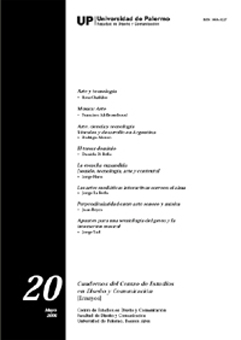El tercer dominio
Abstract
The incorporation of electronics and informatics in the field of communication and art –known in the ‘60s
“computer art” and later the foray of digital medias according to a merged or differentiated use, the interactive-gesture possibility and the treatment of the idea of art as an information category- makes a work come up, which can be understood as a device ready to generate or deploy a resort of art, an installation, intervention or playful, media and interactive put on. This situation has changed the concept of the work and its phenomenological record, and expands it into the universe of transmission and massive circulation, moves it away from the romantic concept that guided and still guides most of the ideological areas of art, and extends it into the field of experimentation and multiplicity.
The conceptual, poetic and ironic generation of these work proposes a critic, creative and experimental
scenery, which not being static at all, becomes a relative universe as fixed variable of the system.
References
-A.A.V.V. (2006). Wikipedia.com [Diccionario en línea] Disponible en: http://en.wikipedia.org
A.A.V.V.(2006). Answers.com [Diccionario en línea] Disponible en: http://www.answers.com
-Adriaansens, Alex. (2005) Understanding New Media Art Education [Resumen en línea] Second Beijing Internacional New Media Arts Exhibition and Symposium. Disponible en: http://newmediabeijing.org/symposium.php?section=3
-Barthes, Roland. (1971). Crítica y verdad. México DF: Siglo XXI Editores. (13.ed 1998)
-Baudrillard, Jean. (1997). La ilusión y desilusión estéticas. Caracas: Monte Avila Editores
-Bourdieu, Pierre. (1988). La distinción: criterio y bases sociales del gusto. Madrid: Taurus.
-Costa, Joan. (2005). La eterna discusión. Disponible en: http://www.foroalfa.com/A.php/La_eterna_e_inutil_discusion/15)
-Danto, Arthur C. (2005). El abuso de la belleza. Buenos Aires: Paidós Estética 37.
-Deleuze, Gilles. (2002). Diferencia y repetición. Buenos Aires: Amorrortu editores.
-Foucault, M. (1991). Saber y verdad. Barcelona: Ed. La Piqueta. Buenos Aires.
-Rajchman, John. (2004). Deleuze un mapa. Lugar Ediciones Nueva Visión.
-Weibel, Peter. (2001). El mundo como interfaz. Revista Elementos No. 40, Vol. 7.
-Zhang, Ga (2005). New Media Art as Global Cultural Alchemy [Resumen en línea] Second Beijing Internacional New Media Arts Exhibition and Symposium. Disponible en: http://newmediabeijing.org/ymposium.php?section=3
Los autores/as que publiquen en esta revista ceden los derechos de autor y de publicación a "Cuadernos del Centro de Estudios de Diseño y Comunicación", Aceptando el registro de su trabajo bajo una licencia de atribución de Creative Commons, que permite a terceros utilizar lo publicado siempre que de el crédito pertinente a los autores y a esta revista.


